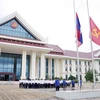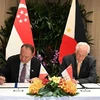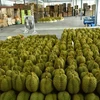Thai rice prices have been tumbling and are expected to keep dropping over the next few weeks as more supply comes to market and after the government was forced to shelve a controversial scheme to support farmers.
According to Reuters, falling prices could prolong protests on the streets of Bangkok by farmers demanding outstanding payments from the canned subsidy programme while piling further pressure on the caretaker government of Prime Minister Yingluck Shinawatra.
The price of common grade 5-percent broken Thai white rice fell 12 percent from early this year to 390 USD per tonne on March 28, traders said. It stood at around 410 USD last week.
"Rising supply during the harvesting season and government rice stock sales have dragged prices down," said a Bangkok-based trader.
Harvesting of the second crop began last month, with around 10 million tonnes of paddy expected to be reaped.
The Thai government has also offloaded 730,000 tonnes of rice from its stocks, saying it plans to sell more to raise funds.
Since the demise of the programme, domestic paddy prices have fallen sharply to 5,500 THB (170 USD) per tonne, below the 15,000 THB the government paid under the intervention scheme.
Looking for outstanding payments and financial support from the government, farmers have been protesting in Bangkok since mid-February, blocking traffic in front of the Ministry of Commerce.-VNA
According to Reuters, falling prices could prolong protests on the streets of Bangkok by farmers demanding outstanding payments from the canned subsidy programme while piling further pressure on the caretaker government of Prime Minister Yingluck Shinawatra.
The price of common grade 5-percent broken Thai white rice fell 12 percent from early this year to 390 USD per tonne on March 28, traders said. It stood at around 410 USD last week.
"Rising supply during the harvesting season and government rice stock sales have dragged prices down," said a Bangkok-based trader.
Harvesting of the second crop began last month, with around 10 million tonnes of paddy expected to be reaped.
The Thai government has also offloaded 730,000 tonnes of rice from its stocks, saying it plans to sell more to raise funds.
Since the demise of the programme, domestic paddy prices have fallen sharply to 5,500 THB (170 USD) per tonne, below the 15,000 THB the government paid under the intervention scheme.
Looking for outstanding payments and financial support from the government, farmers have been protesting in Bangkok since mid-February, blocking traffic in front of the Ministry of Commerce.-VNA



















